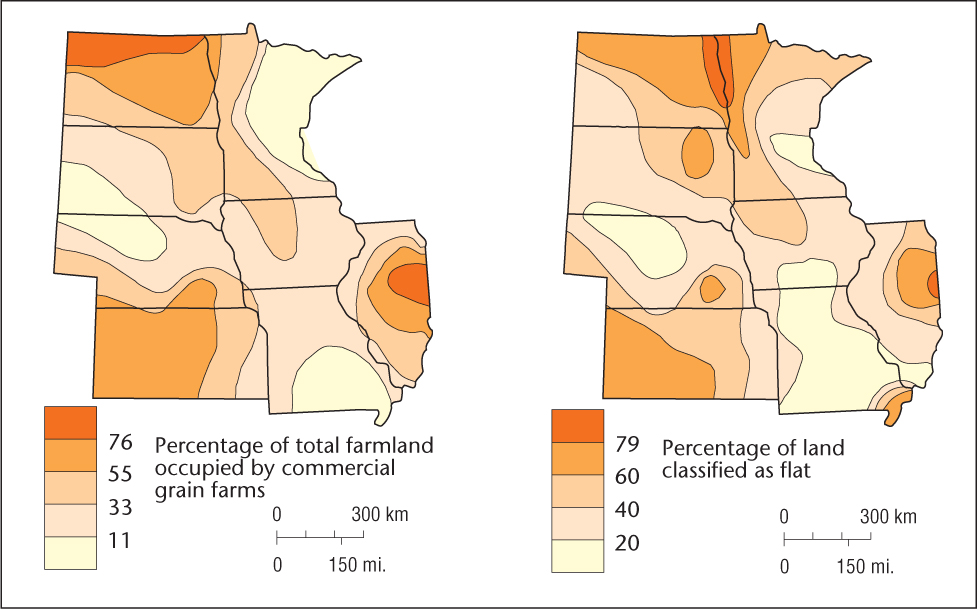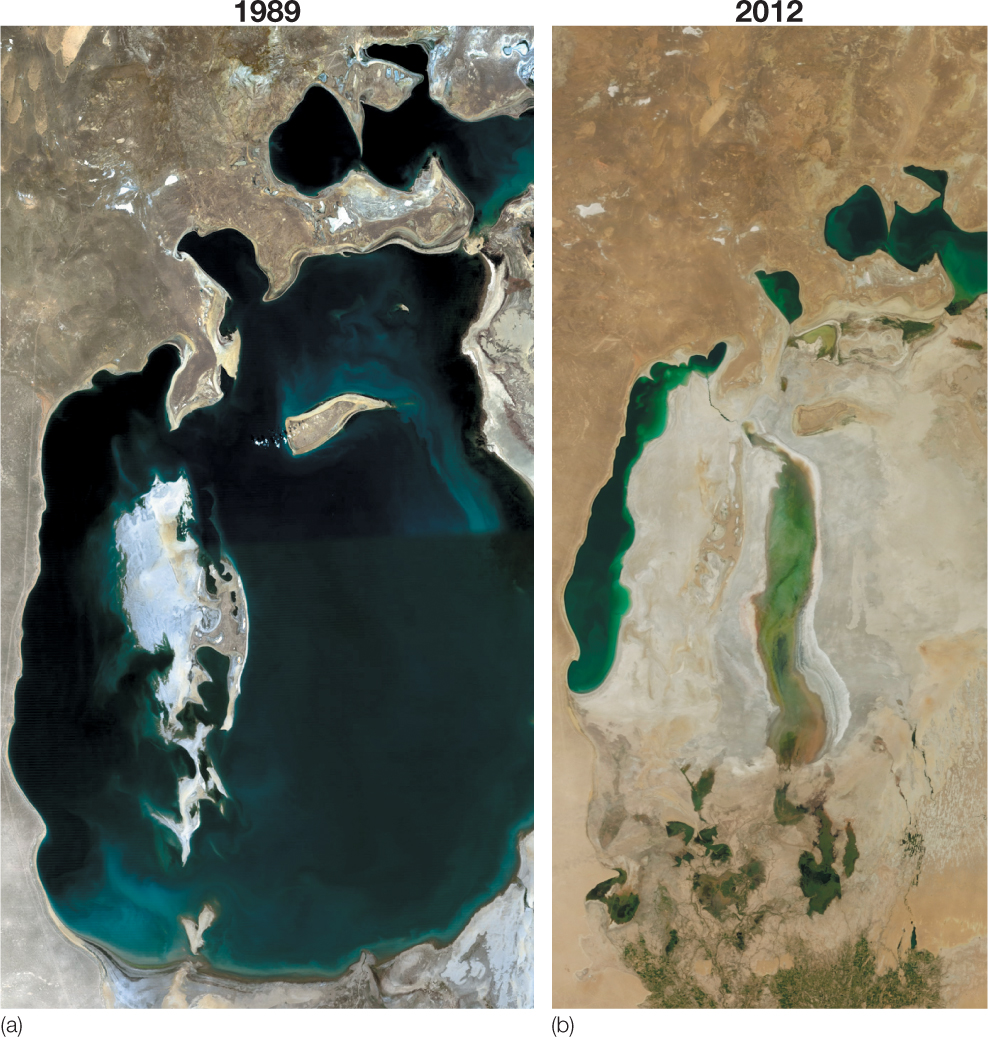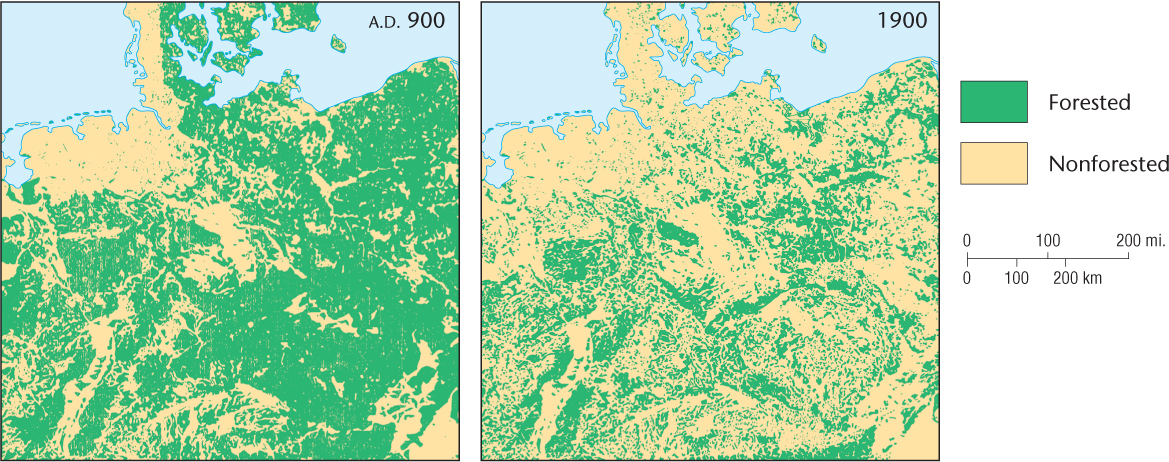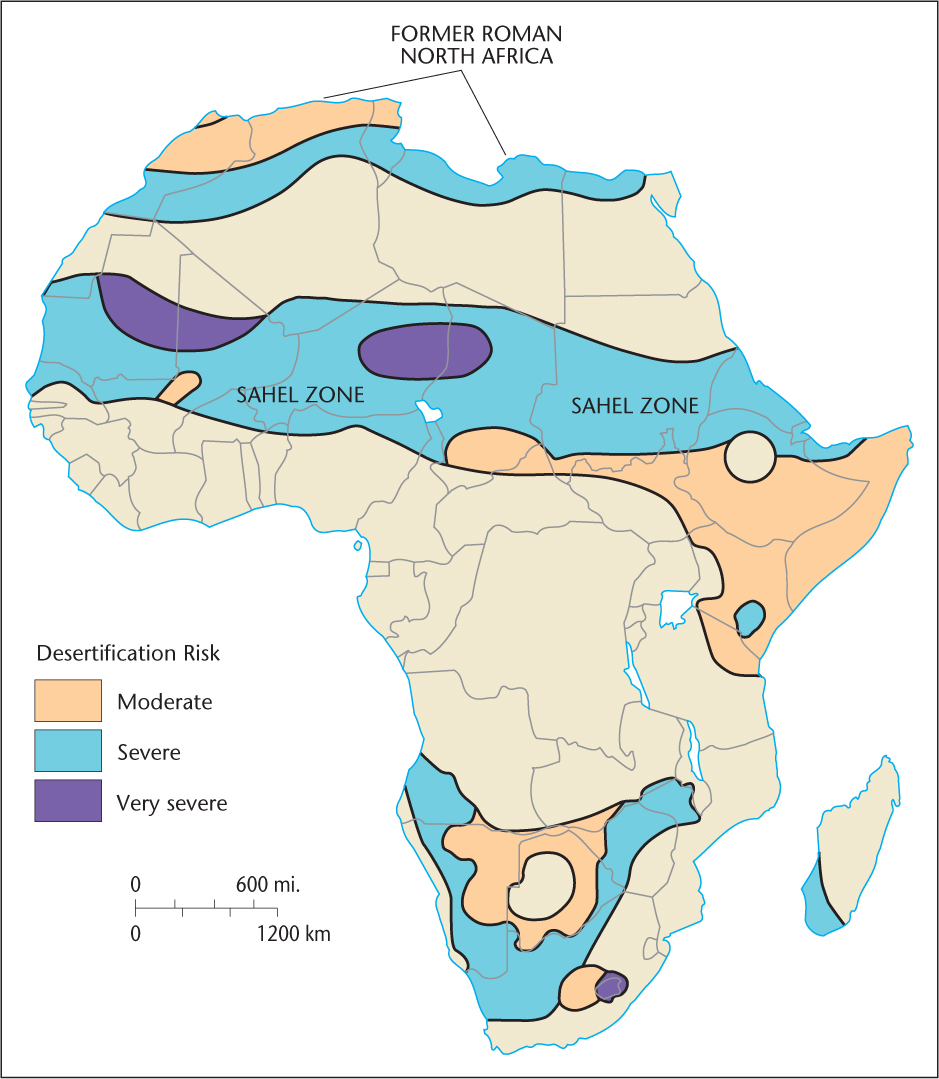Agricultural Ecology
Agricultural Ecology

How are environment-culture relations expressed through the production and consumption of food? Agriculture has been the fundamental encounter between culture and the environment for more than 10,000 years, as human labor is mixed with nature’s bounty to produce our sustenance. What we eat and how we eat it is a basic source of cultural identity. In many ways, the map of agricultural regions (see Figure 8.1) reflects human adaptation to environmental influences. At the same time, thousands of years of agricultural use of the land has led to massive alterations in our natural environment.
231
Cultural Adaptation, Nature, and Technology
Cultural Adaptation, Nature, and Technology
Historically, climate and the physical environment have exerted the greatest influence on agriculture. People have had to adjust their subsistence strategies and techniques to the prevailing regional climate conditions. In addition, soils have played an influential role in both agricultural practices and food provisioning. Swidden cultivation in part reflects an adaptation to poor tropical soils, which rapidly lose their fertility when farmed. Peasant agriculture, by contrast, often owes its high productivity to the long-lived fertility of local volcanic soils. Terrain has also influenced agriculture, as farmers tended to cultivate relatively level areas (Figure 8.21). In sum, the constraints of climate, soil, and terrain historically have limited the types of crops that could be grown and the cultivation methods that could be practiced.

Thinking Geographically
Question 8.24
oISbPmM5Z14XoSzZ8BTWQaHQKf/AjGMnlsHufv/G/7e28UJYAgkD+BEElYJlRbh5G1d/KVj6oPiNUG9UcEDGLDaNFEGQgnPhdONowrJgdoLZLdS4iayjGg==In recent centuries, markets, technology, and capital investment have greatly altered the spatial patterns of agriculture that climate and soils had historically shaped. Expanding global-scale markets for agricultural commodities such as sugar, coffee, and edible oils have reduced millions of acres of biologically diverse tropical forests to monocrop plantations. Synthetic fertilizers and petroleum-based insecticides and herbicides, widely available in developed countries after World War II, helped boost agricultural productivity to unimagined levels. Massive dams and large-scale irrigation systems have caused the desert to bloom from central Asia to the Americas, converting, for example, the semiarid Central Valley of California into the world’s most productive agricultural region.
232
The ecological price of such technological miracles is high. Drainage and land reclamation destroy wetlands and associated biodiversity. The application of synthetic fertilizers results in nutrient-rich runoff from farms that enters freshwater systems as pollution, lowering water quality, destroying aquatic habitat, and reducing biodiversity. Agrochemicals also enter the environment as runoff, as residue on food crops, and in the tissues of livestock. These chemicals ultimately reduce biodiversity, pollute water systems, and cause increases in the rates of cancer and birth defects in humans and animals.
In the context of global climate change, great concern exists about the long-term sustainability of modern agricultural practices. In many parts of the world, groundwater is being pumped to the surface faster than it can be replenished and reservoirs are approaching the end of their life spans. Well-and-pump irrigation has drastically lowered the water table in parts of the American Great Plains, particularly Texas, causing ancient springs to go dry. Climate change data from the distant past and computer models of future climate conditions suggest that the U.S. Southwest is likely entering a drier climate era. Lake Mead, the giant reservoir in Arizona and Nevada that helps supply water to California’s cities and farms, was only 49 percent full in 2006 and is unlikely ever to be full again. This region, the most agriculturally productive in the world, will face increasingly difficult questions regarding the viability of current farming and land-use practices.
Another area where arid land irrigation has had severe ecological consequences lies in the Aral Sea on the borderland between Kazakhstan and Uzbekistan in central Asia. Since the latter half of the twentieth century, this sea—once the world’s fourth largest—has shrunk to a fraction of its former surface area (Figure 8.22), forming two separate and much smaller seas, Large Aral and Small Aral. This environmental crisis is the result of excessive extraction of water from the rivers that feed the lake. The water is used to irrigate farmlands surrounding the sea, which would otherwise be infertile, as well as to sustain people and livestock in the region. As a result, the source rivers no longer reach the dying sea. It is not possible to restore the original borders of the sea, but environmental groups have urged countries around it to take action to prevent its complete extinction, which is predicted to occur in 10 to 15 years. Nevertheless, four out of the five countries rimming the lake, including Kazakhstan, plan to increase extraction from source rivers to meet the needs of agricultural development for their growing populations.

Thinking Geographically
Question 8.25
NQMKSEM6aRQwKroj8W0AXOqKywZE9HFFXtIoueB5egzLmgFcq2qLxlXwhYb16XHa2imftfij+JPI0PZOog5bGxGnBRk9tIMPwAlW3FQqZytRD6tNwStLl7x6ExLpqJGyThe consequences of the diminishing Aral Sea extend far beyond the loss of habitat for many marine plants and animals. Contamination of the lake with agrochemicals that wash in from adjacent farm fields has resulted in tons of toxic dust that has dispersed to areas as far away as the Antarctic, Greenland, and Europe. Sandstorms, from desert areas where the sea used to be, also now plague regions as far as 310 miles (500 kilometers) away.
Sustainable Agriculture
Sustainable Agriculture
sustainability The survival of a land-use system for centuries or millennia without destruction of the environmental base.
As cultural geography studies by Zimmerer and many others have shown, local and indigenous knowledge about ecological conditions can be a foundation for sustainable agriculture. Sustainability—the survival of a land-use system for centuries or millennia without destruction of the environmental base—is the central ecological issue confronting agriculture today. The case of the Quichua peasants offers an optimistic assessment of indigenous knowledge as the basis for long-term sustainability. Their response to contemporary market pressures suggests that development and conservation can be compatible. Their knowledge of complex and variable ecological conditions in the Andes has allowed them to farm highly diverse crop varieties, a practice that in some cases has been strengthened by economic development.
Another example of sustainable indigenous agriculture is the paddy rice farming that occurs near the margins of the Asian wet-rice region, where unreliable rainfall causes harvests to vary greatly from one year to the next. Farmers have developed complex cultivation strategies to avert periodic famine, including growing many varieties of rice. These farmers, including those in parts of Thailand, almost universally rejected the green revolution. The simplistic advice given to them by agricultural experts working for the Thai government was inappropriate for their marginal lands. Based on generations of experimentation, the local farmers knew that their traditional diversified adaptive strategy was superior. In West Africa, peasant grain, root, and livestock farmers have also developed adaptations to local environmental influences. They raise a multiplicity of crops on the more humid lands near the coast. Moving inland toward the drier interior, farmers plant fewer kinds of crops but grow more drought-resistant varieties. Having observed many cases like these in which local practices have proved effective and sustainable, most geographers now agree that agricultural experts need to consider indigenous knowledge when devising development plans.
233
Intensity of Land Use
Intensity of Land Use
Great spatial variation exists in the intensity of rural land use. As noted earlier in this chapter, intensive agriculture means that a large amount of human labor or investment capital, or both, is put into each acre or hectare of land, with the goal of obtaining the greatest output. Intensity can be calculated by measuring either energy input or level of productivity. In much of the world, especially the paddy rice areas of Asia, high intensity is achieved through prodigious use of human labor, which results in a rice output per unit of land that is the highest in the world. In Western countries, high intensity is achieved through the use of massive amounts of investment capital for machines, fertilizers, and pesticides, resulting in the highest agricultural productivity per capita found anywhere.
Many geographers support the theory that increased land-use intensity is a common response to population growth. As demographic pressure mounts, farmers systematically discard the more geographically extensive adaptive strategies to focus on those that provide greater yield per unit of land. In this manner, the population increase is accommodated. The resultant farming system may be riskier, because it offers fewer options and possesses greater potential for environmental modification, but it does yield more food—at least in the short run. Other geographers reject this theory, arguing instead that increases in population density follow innovations, such as the introduction of new high-calorie crops, which lead to greater land-use intensity.
The Desertification Debate
The Desertification Debate
Over the millennia, as dependence on agriculture grew and as population increased, humans made ever larger demands on the forests. With the rise of urban civilization and conquering empires, the human transformation of forests to fields accelerated and expanded. In many parts of China, India, and the Mediterranean lands, forests virtually vanished. In transalpine Europe, the United States, and some other areas, they were greatly reduced (Figure 8.23).
234

Thinking Geographically
Question 8.26
TB5ptSsPPDkCh8K4NfshgQpMv1eFvoHRxtcayYR8TJmJ3+ZFHyJgdNY957O1vUTp2pRDcTVcdF0=desertification A process whereby human actions unintentionally turn productive lands into deserts through agricultural and pastoral misuse, destroying vegetation and soil to the point where they cannot regenerate.
Grasslands suffered similar modifications. Farmers occasionally plowed grasslands that were too dry for sustainable crop production, and herders sometimes damaged semiarid pastures through overgrazing. The result could be desertification, a process whereby human actions unintentionally turn productive lands into deserts through agricultural and pastoral misuse, destroying vegetation and soil to the point where they cannot regenerate. Desertification was first studied half a century ago by geographer Rhoads Murphey. He argued that farmers caused substantial parts of North Africa to be added to the margins of the Sahara Desert. He noted the catastrophic decline of countries such as Libya and Tunisia in the 1500 years since the time of Roman rule, when North Africa served as the “granary of the Empire,” yielding huge wheat harvests.
More recent research on desertification has centered on the Sahel, a semiarid tropical savanna region just south of the Sahara Desert in Africa (Figure 8.24). A series of droughts in the 1970s and 1980s raised concern that the Sahel was becoming desertified. This was a focal point of discussion at the 1977 UN Conference on Desertification. One theory advanced at the conference was that farmers and pastoralists were overusing the land, destroying vegetation to such an extent that the plant life could not regenerate. Lands that had been covered with pastures and fields could become permanently joined with the adjacent Sahara. In sum, researchers theorized that Africans were overgrazing rangelands and using poor cultivation practices, which were causing the desert to spread southward.

Thinking Geographically
Question 8.27
e9zppQIyL22N28Pn+2QHjkZNA0v40QBrfsOhY9iXegsl0HzSenoHCUwC/R9Cocxdo3U34Q4hQqaxfg6KsnEVduaAmopGI87f6GDzt+UPTxkNs7botMphv4K8hWDi7XSYhYqZGdfNgMUeJ3gxuDB2M+iRDKmtN9UOmZ90KicCIkowblHbw3unDq/lvVGsCJmfiinekwefrJoGcZVy9kMEfh4h0GskyVkREToT17IR4rz7L01mIn the intervening years, substantial evidence, much of it obtained through satellite images, has raised questions about this theorized link between land use and the advancing Sahara Desert. Satellite imagery suggests to many researchers that the semiarid lands possess more resiliency than was once thought. Since 1960, they claim that the Sahara-Sahel boundary has not migrated steadily south but fluctuated as it always has, responding to wetter and drier years. New research by geographers and anthropologists also challenges the general claim that Africans were misusing the land. These findings suggest that African land-use practices in the region are highly adapted to the variable and unpredictable environments of the Sahel. A great deal of careful research is needed to distinguish the fluctuations caused by climate variability from permanent ecological damage caused by human misuse. For now, the debate continues over the extent and sources of desertification in the Sahel.
Reflecting on Geography
Question 8.28
43RimcvOKBlJ0U6F2sdMWUQayIR+Z510n63oJMFCpmIEzdhR0uAwtmeRx87e0k/jEVUCSbXXBiATuYscoKqMtNsvFsGTmwItVR955M97Agp+SOOpReyLZIjRsV9kjbN9mtfmpPX1jtNqJPwSTSaE8Rxex4Za1Wz0LcNfQQ==Environmental Perception by Agriculturists
Environmental Perception by Agriculturists
People perceive the physical environment through the lenses of their culture. Each person’s agricultural heritage can be influential in shaping these perceptions. This is not surprising, because human survival depends on how successfully people can adjust their ways of making a living to environmental conditions.
The Great Plains of the United States provide the setting for how an agricultural experience in one environment influenced farmers’ environmental perceptions and subsequent behavior when they began farming in the Great Plains. The Plains farmers who came from the humid eastern United States consistently underestimated the problem of drought in their new home. In the 1960s, geographer Thomas Saarinen pointed out that almost every Great Plains farmer, even the oldest and most experienced of the farmers, underestimated the frequency of the dry periods. By contrast, culturally preadapted German-speaking immigrants from the steppes of Russia and Ukraine, an area very much like the American Great Plains, accurately perceived the new land and experienced fewer problems due to drought.
235
Farmers rely on climatic stability. A sudden spell of unusual weather can change agriculturists’ environmental perceptions. Geographer John Cross studied Wisconsin agriculture following a series of floods, droughts, and other anomalies. He found that two-thirds of all Wisconsin dairy farmers now believe the climate is changing for the worse, and fully one-third told him that continued climatic variability threatened their operations. Perhaps they perceive the environmental hazard to be greater than it really is, but they make decisions based on their perceptions.
Environmental perceptions also operate at the level of society. Such is the case in the U.S. Southwest, where early twentieth century dam building on the Colorado River allowed for the expansion of irrigated agriculture and an urban population boom that is still going. The widespread perception that water is abundant, however, has been based on a misreading of the climate. The early 1920s, when the Colorado River flow was divided among western states, was an unusually wet period in the region’s climate. Officials greatly overestimated average river flow when allocating water rights, thus creating a perception of water abundance. The region is now entering a drier phase, partly associated with global warming, which is bound to put agriculture in increasing conflict with urban demands. Because migration into the Southwest continues, where urban growth outpaces that of the rest of the country, we can conclude that perceptions have yet to catch up with the reality of water scarcity.
Organic Agriculture
Organic Agriculture
organic agriculture A form of farming that relies on manuring, mulching, and biological pest control and rejects the use of synthetic fertilizers, insecticides, herbicides, and genetically modified crops.
Alarmed by the ecological and health hazards of chemical-dependent, industrialized agriculture, a small counterculture movement emerged in the United States and Europe in the 1960s and 1970s. Geographer Julie Guthman labels this the organic farming movement. For Guthman, the movement in the United States saw organic agriculture as a solution to a range of social, cultural, political, and environmental ills. These in cluded the loss of small, family-owned and -operated farms, environmental pollution from industrial agriculture, corporate control of the food system, and the nutritional deficiencies of highly processed foods. Organic agriculture relies on manuring, mulching, and biological pest control and rejects the use of synthetic fertilizers, insecticides, herbicides, and genetically modified crops.
By legislating regulatory standards for organic agriculture, the U.S. state and federal governments provided organic farmers the basis for differentiating their product in the marketplace. This in turn has allowed producers and retailers to charge consumers a premium. Premium pricing has encouraged many producers to switch to organic agriculture. The organic food market is now the most rapidly growing (and most profitable) agricultural sector. Affluent consumer demand for organics in developed countries, while only 1 to 3 percent of national retail sales, is growing at the phenomenal pace of 20 to 25 percent annually.
236
Green Fuels from Agriculture
Green Fuels from Agriculture
biofuel Broadly, any form of energy derived from biological matter, increasingly used in reference to replacements for fossil fuels in internal combustion engines, industrial processes, and the heating and cooling of buildings.
Henry Ford fueled his first car with alcohol, and Rudolf Diesel ran his engine on fuel made from peanut oil. They soon abandoned these biofuels, however, for nonrenewable fossil fuels derived from “rock oil,” and the rest is history. The modern global economy is dependent on fossil fuels to produce everything that we eat, wear, listen to, read, and live in. Now fossil fuels, particularly oil, have become scarce, causing prices and political uncertainties to increase. In addition, fossil-fuel combustion is a source of atmospheric greenhouse gases, which are partly responsible for global warming. Thus, an urgent search is under way to find alternative, renewable fuel supplies, and agriculture has become one of the main sources.
How can agriculture be a source of energy for industry? By tapping the simple process of fermentation, many plant materials can be converted to a combustible alcohol, ethanol. In the United States, corn is the main source of ethanol, and new ethanol plants are springing up across the Corn Belt in the midwestern United States. To encourage the growth of these new modes of fuel production, the U.S. government instituted subsidies for America’s corn ethanol producers amounting to almost $6 billion per year. These subsidies recently expired, so corn ethanol producers now compete on the U.S. energy market without the assistance of governmental supports. Experts predict, however, that rising oil prices globally will likely ensure that corn ethanol production remains competitive in years to come without the help of subsidies. In addition, other forms of biofuel from nonfood crops such as wood chips and switchgrass (grown in warm-season climates throughout North America) are still supported by federal subsidies due to higher research and development costs associated with this type of ethanol production.
While the use of food crops (mainly corn) for the production of biofuels may help ease demands on dwindling world fossil-fuel reserves, it has also elevated corn prices worldwide. Higher prices, though beneficial to corn producers, have led to less affordable corn available to countries using it primarily for human consumption. As a result, some humanitarian organizations, as well as the United Nations, have taken a position against increased biofuel production, arguing that it is jeopardizing food security for some developing countries.
In addition, the production of biofuels from tropical crops, such as oil palm and sugarcane, has led to the clear-cutting of rainforest vegetation in many regions. Many climate researchers oppose this deforestation, warning that the alteration of delicate tropical ecosystems will contribute to global warming. Debates among environmentalists, biofuel producers, and adherents will likely continue on this issue, though alternatives for biofuel crop production on abandoned agricultural lands and other nonforested lands are being sought. Ultimately, whether biofuels from agriculture will produce a sustainable, environmentally friendly alternative to fossil fuels remains to be seen.